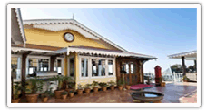|
|
|
| |
Travel destination in India, Hampi |
| |
[ Book Hotels in Hampi ] |
[ other Travel Destinations in India ] |
| |
General Information about HAMPI |
Hampi :
Area : 26 sq km.
Altitude : 1,547 metres above sea level.
Language : Kannad, Telgu and English.
State : Karnataka.
STD Code : 08394.
Best Time to Visit : September and March.
Location : 343 km from Bangalore . |
About Hampi
Hampi is a village in southern Karnataka , India . Hampi is located within the ruins of Vijayanagara , the former capital of the Vijayanagara empire .
Hampi is situated on the banks of the Tungabhadra River . It is 343 km from Bangalore , 254 km from Bijapur and 74 km away from Bellary . Hospet , 13 km away, is the nearest taluka headquarters. The chief languages spoken are Kannada , Telugu and English . The principal industries of the village are agriculture , the support of the Virupaksha temple and some other local holy places in the vicinity, and tourism. The annual Vijayanagar Festival is organized by the Government of Karnataka in November.
Hampi, are one of the most fascinating historical sites in south India. The superb ruins are set in a strange and beautiful boulder strewn landscape which has an almost magical quality.Hampi has become a thriving travelers center and most people stay at least a couple of days to soak up the atmosphere and explore the area. If you're in a hurry, you can see the main sites in one day, either by bicycle or on foot.
HOW TO REACH
By Air : The nearest air station at Tornagallu in Sandur Taluk which is 32 kms. from Hospet. The second nearest airport is Bellary(74 kms). Other convenient airports are at Belgaum (190 kms) and Bangalore(353 kms).
By Rail : Hospet is the nearest rail head (13 kms). Hospet is linked by rail to Bangalore, Bijapur,Hubli and Guntakal.
By Road : Hampi is 350 kms from Bangalore. KSRTC Buses ply regularly from Hospet.
FORTS & PLACES TO VISIT IN HAMPI
• Virupaksha Temple : The Virupaksha Temple located at the western edge is one of the earliest constructions in the city. The main shrine is dedicated to Virupaksha, a form of Lord Vishnu. Overlooking Virupaksha temple to the South, Hemakuta hill has several scattered ruins, which includes Jain temples and a monolithic structure of Narasimha.
• Vithala Temple : Vittala temple is about 2 kms away to the east of Hampi bazaar. Relatively well preserved, the ruins of the temple are now a World Heritage. The temples beautiful sculptures exhibits the richness of Vijayanagar Art. The outer pillars are known as the 'Musical Pillars' as they echoes when tapped, although this practice is now discouraged to avoid further damage. The temple also displays an beautifully carved stone chariot in the temple courtyard containing an image of Garuda
• Hazara Rama Temple : The temple built within rectangular complex is located at the heart of the royal centre. The temple dating back to early 15th century has intricately carved basalt pillars showcasing the incarnations of Shri Vishnu. Around the exterior walls of the hall are three rows of sculptures imaging the main events from the Ramayana.
• The Queen's Bath : The Queen's Bath looks rather block-like from the outside. Inside, however, gallery-verandas, with overhanging Rajasthani balconies, encircle a 15-metre square bath. Once, cool, perfumed water poured in a minor waterfall at one side and flowed out through an underground drain. The bath, though carefully shielded on all sides, was open to the sky. It was a celebration of the good life, which, in many ways, was the leitmotif of Hampi.
• Lotus Palace : Near the Hazara Ram Temple, in the walled area of zenana (women's quarters), there is an exquisite pavilion called the Lotus Palace. It is believed that the women of the royal family who lived in the nearby Queens' Palace disported themselves in the water pavilion within their protected enclosure and met in the Lotus Palace. Its inflicted arches are particularly intriguing. This palace is a blend of Indo-Islamic architecture and gets its name from the lotus bud carved on its domed and vaulted ceiling. The Mughal monuments in Agra, built a century later, show modified variations of such features. |
|
|
|
|
|
|







